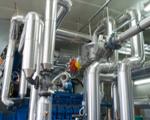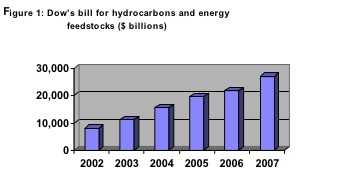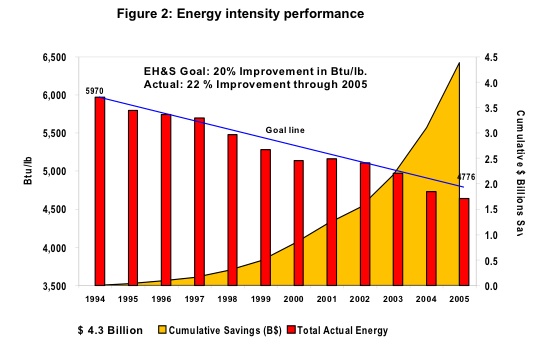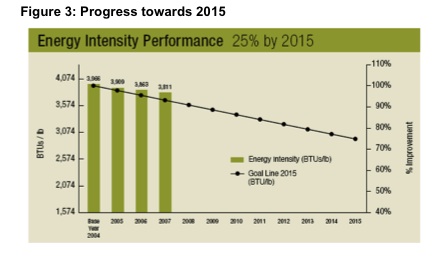Dow: Reaching 'Stretch Goals' for Energy Efficiency
 [Editor’s Note: This case study is part of a series of profiles of World Business Council on Sustainable Development member company good practice examples on energy efficiency.]
[Editor’s Note: This case study is part of a series of profiles of World Business Council on Sustainable Development member company good practice examples on energy efficiency.]
The business case for energy efficiency at Dow is simple: Saving energy makes the company money. Dow benefits from wider uptake of energy efficiency standards through less upward price pressure on the hydrocarbons it uses as feedstocks, and greater demand for its efficiency-related products.
The Situation
The Dow Chemical Company provides customers in more than 175 countries with over 300 diverse chemical products. Its products can be found in everything from pharmaceuticals to paints, packaging to building products. The company has 46,000 employees worldwide and annual sales of $54 billion.
Dow’s operations require over 3,700 MW of electricity and over 9 million kilograms of steam per hour. And the company does not just rely on petrochemicals for fuel.
At its core the company’s business uses the energy from oil and gas to make and break the chemical bonds in feedstocks such as ethane, propane butane and naphtha, to produce the chemical components for medicines, shampoo, insecticides, paint, glues, lubricants, plastics and thousands of other everyday products.
In 2007 the company used early 850,000 barrels of oil equivalents each day, to supply its energy and feedstock needs globally. That is more than the oil consumption of the Netherlands. 80 percent of this went into feedstocks and 20 percent into fuel. The total fossil fuel bill came to approximately $27 billion; accounting for nearly half of the company’s operating costs. This makes it the one of the world’s largest industrial consumers of energy.
Rising prices have tripled Dow’s annual fossil-fuel bill over the past five years (see Figure 1). In a global economy where Dow’s competitors can sometimes have access to energy and raw materials at a fraction of its cost, continually improving efficiency is critical to Dow’s business strategy. 
Dow Chairman and CEO Andrew Liveris believes that reducing energy use, both in production and through the use of Dow’s products, is good for business, for society and for the environment, "energy efficiency plays a key role in our efforts to address the parallel issues of restricted resources, escalating energy costs and climate change," he says.
Targets
Between 1990 and 1994 Dow reduced the energy consumed to make each pound of its product by 20 percent through moves such as cogeneration in which steam and power are produced together.
It then went on to set itself a series of "stretch" targets for energy efficiency:
• In 1995 Dow made a commitment to reduce energy intensity by a further 20 percent per pound of product by 2005.
• In 2005 Dow set a target of reducing energy intensity by a further 25 percent per pound of product by 2015.
Dow has mapped out a set of goals that will allow it to turn back from rising greenhouse gas (GHG) emissions by 2025. From then on the company’s goal will be to begin making absolute reductions in its GHG emissions, while continuing to grow the company and its impacts on human welfare.
The overall objective to slow, stop, and ultimately reverse the GHG emissions of the company is an ambitious internal objective, in line with Dow’s commitment to be part of the solution.
Activities
Dow Chemical has been engaged in plant based energy management programs since very early in the company’s history. But it was not until it made a public commitment to reduce its energy intensity that it began to develop a formal, comprehensive energy management system.
Over the years, cultural, organizational and management approaches have been tried, tested and honed into a comprehensive Energy Efficiency and Conservation Management System which is now applied throughout the global organization.
Key components of this comprehensive approach are leadership commitment, organizational alignment, reporting and measurement, and the use of Six Sigma tools to identify and close energy efficiency gaps.
Clear leadership commitment
Some energy efficiency improvements require capital investment, others can be done at low cost, by altering policies, behavior or accepted practice. What they all depend on is the will to continually find and reap the opportunities for doing things better and more efficiently. This requires top executive commitment and leadership.
Dow has created a Strategy Board of very senior leaders, charged with driving energy efficiency as part of Dow’s approach to climate change and energy policy. This leadership team establishes the company’s energy policy and goals and sets priorities. Each individual business then develops its own goals in support of the overall business strategy, provides resources and capital funding, and measures individual leader performance in delivering energy efficiency.
This, says Andrew Liveris, is what has enabled Dow to reach goals, which he admits were considered unreachable when they were first set, back in 1995. "We didn’t have the technology," he said, "but by establishing the signals within our own corporation and having that behind us, we discovered that amazing things can happen when you have the skills."
An Organization Aligned to Saving Energy
Dow’s Energy Efficiency and Conservation Management System makes energy efficiency and conservation a normal part of everyday work processes. A well-defined, institutionalized structure drives the implementation of energy efficiency and conservation objectives at corporate, business, site and individual levels:
• Corporate – Dow’s Global Energy Efficiency and Conservation Leader oversees the overall energy management program, establishing and maintaining its management systems, work processes, energy accounting rules, performance tracking and reporting systems, overall results analysis and internal program effectiveness assessment program. He works with Energy Efficiency and Conservation Leaders in each of Dow’s businesses and its largest sites to implement the global program.
• Business – Dow’s business is organized in 28 cross-geographic Business Groups focused on different product segments. Each of these groups has its own 10-year energy improvement plan as part of the overall business strategy and capital funding program. In each Group the Energy Efficiency and Conservation Management Program Leader is accountable for implementing and tracking progress of the energy improvement plan within their respective group.
• Site – Dow’s 13 largest energy-consuming sites, account for over 90 percent of energy usage. At these large, integrated sites there are numerous opportunities to improve energy flow and use between different production units as well as inside the units. Energy Teams at each site actively engage employees, subject matter experts, engineering and technology resources and external experts in energy efficiency
improvement projects across each site.
• Individual – Energy efficiency is tracked in every Dow plant and is part of every engineer’s education and every operator’s training and is recognized as a component of competent business leadership. Energy efficiency targets are integrated into individual accountability and incentives, with bonuses for many individuals linked to the achievement of energy goals.
Systems for Tracking Progress
Every one of Dow’s 120 Dow sites and 685 plants and facilities reports on its energy intensity. Steam, electricity, compressed air, fuel gas and all other forms of energy consumed in the production of Dow products are measured and converted into a total energy intensity measure for each plant. The energy performance of each plant is reviewed and analyzed on a quarterly basis.
Anyone within Dow can access this data on the intranet, viewing and comparing historical performance, progression trends, current quarter energy consumption, production, and energy intensity for a single plant, a whole site, a business group, a region or the entire Dow Corporation.
Businesses use this to benchmark their plants, estimate potential energy savings and develop long-range improvement plans.
A Proven Methodology
Dow has been using Six Sigma since 1999 as its corporate wide methodology to accelerate improvement in quality and productivity. The Six Sigma process of problem measurement, rigorous analysis, focused improvement (of the problem not the symptom) and controls to ensure that problems stay fixed is well suited to identifying and pursuing energy efficiency opportunities. The Six Sigma methodology is therefore the primary methodology used by technology centers and site energy teams to identify and correct inefficiencies, find optimum solutions to defects and establish control plans to sustain gains in energy efficiency. Key steps in the improvement cycle include:
• Identifying energy savings opportunities through business and technology reviews, benchmarking studies, audits and internal and external energy assessments
• Prioritizing projects on the basis of cost and energy efficiency, as part of the process of developing 10-year energy improvement plans
• Implementing improvements with funding secured within the Capital Funding Program and the Business Strategic Plan
• Tracking results through the Energy Measurement and Reporting System
• Reviewing and updating the Energy Improvement Plan and annual targets.
In addition, all new capital project work processes have to include formal energy reviews to ensure that design of new facilities and equipment is optimized.
However, Fred Moore, the Implementation Leader for Dow’s Sustainability 2015 goal on Energy Efficiency, stresses that this system is not monolithic, nor does it imply that Dow knows it all when it comes to saving energy. He recalls how a Department of Energy assessor visiting one of their Texas City plants as part of the US government’s "Save Energy Now" program noticed that two pumps were being used where one would do. After some discussion, the engineer in charge agreed to have a trial at turning off one pump. "To his amazement it worked," says Moore. "That one small step saved the company $230,000 per year." All in all, external advice from the "Save Energy Now" program has helped Dow identify 3.75 trillion Btus (1 BTU, or British Thermal Unit, equals 1055 joules) in potential energy savings valued at more than $30 million per year.
Dow has long recognized that energy efficiency and conservation ideas can come from anywhere. Its Waste Reduction Always Pays (WRAP) initiative has given awards to employees who have come up with ideas for reprocessing waste into raw materials. Since its inception in 1986, 395 WRAP projects have accounted for the reduction of 8 trillion Btus of energy.
Results
Key examples of the energy saving opportunities realized through Dow’s Energy Efficiency and Conservation Management System include:
• Combined heat and power – Almost 85 percent of Dow’s electricity in the United States and 70 percent worldwide is now produced through cogeneration. Cogeneration can use up to 40 percent less fuel than conventional power generation.
• Improved process efficiency – For example, the Ethylene Dichloride/Vinyl Chloride Monomer business unit has improved the efficiency of its furnaces, both reducing fuel use and increasing the conversion rate from raw material to final product. They also reduced steam consumption by optimizing steam and distillation systems as well as increasing energy recovery from systems already in place. Overall energy savings from these projects exceeded $5.8 million in 2004.
• Automatic controls – Wherever possible automatic controls are used to ensure that machinery is operating at optimum efficiency. For example, at the Dow site in Boehlen, Germany, steam production was decreased by improved pressure and flow control and improved steam load shedding on the steam distribution system. This project reduced fuel oil purchases by $2.3 million per year.
• Energy efficient equipment – The most energy-efficient designs are selected for new equipment. For example, at Dow’s Seadrift site, an existing air compressor was improved with a new compressor wheel design that is much more energy efficient.
The result was reduced consumption of fuel gas to the gas turbine used to drive the compressor. The old machine consumed about 8,000 pounds per hour of fuel gas for maximum airflow. The new machine reduced the fuel consumption to about 6,000 pounds per hour. The annual fuel savings is estimated to be $3.2 million per year.
• Energy recovery from waste – At Dow’s Freeport, TX site, hydrogen is being recovered from chlorine production and used for burning in boilers to generate steam and power. This power displaced about 1 million MM Btus of purchased gas per year. Costs savings experienced are approximately $7 million per year.
Dow exceeded its 2005 goal by achieving a 22 percent reduction in energy intensity. Over 10 years it saved approximately 900 trillion Btus – enough to power 8 million homes for a full year (see Figure 2).

Lessons Learned
Fred Moore says that the two keys to Dow’s success in driving down its energy intensity have been pursuing energy efficiency opportunities with the same aggressive implementation as other business goals because they do save money, and engaging with external partners.
• Aggressive implementation – Whether it be Six Sigma type projects, operations optimization, or major process and systems upgrades, aggressive pursuit of energy efficiency goals has enabled Dow to keep capturing savings from efficiency improvements. Moore stresses that solutions that work in one place are quickly implemented across the whole company driven by leadership commitment to achieve energy goals and strong tools for identifying where energy efficiency improvements could create value, Moore notes that "people who think they have picked all the low hanging fruit just aren’t looking hard enough." Indeed, after consistently achieving energy intensity improvements for eighteen years the company is still finding energy efficiency investments that payback over two years.
• External engagement – Dow notes that if the US GDP grew at an average 3 percent rate and that the nation were to improve its energy efficiency by 25 percent between 2005 and 2015, the nation would save the oil equivalent of all the Persian Gulf imports in the 2005 base year. Dow has set such an aggressive goal for itself, targeting a 25 percent improvement in energy efficiency between 2005 and 2015. To make a true impact in the areas of energy efficiency and conservation, Dow leaders believe that the company must engage with customers, industry partners, governments and other experts, to share its technology and to contribute to dialogue on energy issues. Dow supports the call for tougher policies to curb energy consumption by U.S. industry sectors.
Efficiency improvements alone will not solve all of America’s climate and energy challenges, says Liveris, "but it is something that everyone can do right now to make a difference." Dow has advocated for industrial energy efficiency standards in front of the U.S. Congress, within its own industry, and with its customers, including the automobile industry. Dow has also shared its energy efficiency and conservation best practices with other companies, non-governmental and governmental organizations, and has benefited from the external advice and validation from Energy Star and the Department of Energy on energy efficiency and conservation processes.
A new global energy task force led by Dow, the Alliance to Save Energy and the United Nations Foundation was announced at the Energy Efficiency Global Forum and Exposition (EE Global) in November 2007. The new task force is dedicated to pursuing efficiency savings by the major industrial nations as well as promoting a new annual government summit to measure progress. Development of the task force was supported by an analysis commissioned by the United Nations Foundation. The report, Realizing the Potential of Energy Efficiency: Targets, Policies and Measures for G8 Countries, concluded that industrial nations can save enough energy through increased efficiency to move the world closer to an acceptable CO2 level, at a cost that would be repaid largely by energy savings in three to five years.
Next Steps
The 2015 energy intensity target of 25 percent reduction, on top of the 38 percent already achieved since 1990, is clearly a stretch goal. Dow’s energy efficiency and conservation management system, with its focused, consistent and structured approach, execution throughout the organization, and proven methods for identifying and implementing improvement opportunities, has provided a solid launch pad for the company’s aggressive goals for 2015. However, while the company is making progress, year on year energy intensity achievements are currently trailing the goal line (see figure 3).

In some processes, says Moore, the company is already pushing up against thermodynamic limits. He says reaching the 2015 goal will require game changing innovations, in which Dow develops energy alternatives, less carbon-intensive raw material sources, and other products and solutions not yet imagined.
While Dow’s comprehensive Energy Efficiency and Conservation Management System has proved to be an effective vehicle for bringing in a massive harvest of incremental efficiency gains, cultivating game changing innovations requires a different approach says Moore: "Energy efficiency opportunities can be found everywhere, if you look hard enough, but with game changing breakthroughs one, two or three will be a step change. Finding those will be what differentiates Dow."
Dow has therefore committed to invest a significant portion of its research and development to support and develop alternative energy, less CO2-intensive raw material sources, and other breakthrough solutions to contribute to the necessary slow, stop and reverse of non-renewable energy use and climate change, both through the manufacture and use of its products.
Energy Savings Beyond the Fenceline
In addition to energy savings within its own manufacturing processes, Dow has also been developing products that reduce emissions during their use phase.
Products such as thermal insulation, solar panels, diesel filters, more efficient wire and cable formulations for power transmission, and lightweight adhesives for the automotive industry enable Dow customers and users to reduce their own energy use and emissions.
GHG emission reductions achieved through the use of Dow products more than offset the GHGs produced during the manufacture of those products. For example, Dow Automotives solutions reduce vehicle weight, thereby improving fuel economy. Products from Dow Building Solutions save energy. One square foot of one-inch-thick Styrofoam can save 1 ton of CO2 emissions over the average life of a house.
You can return to the main Market News page, or press the Back button on your browser.

